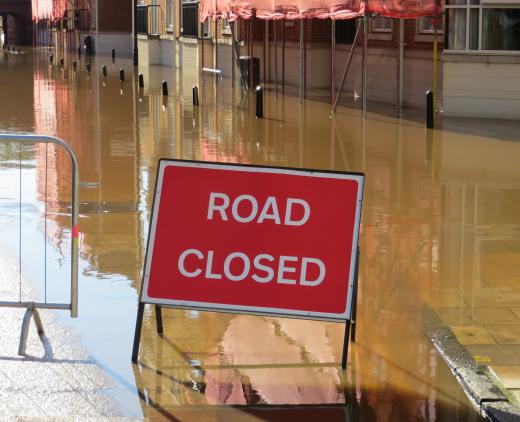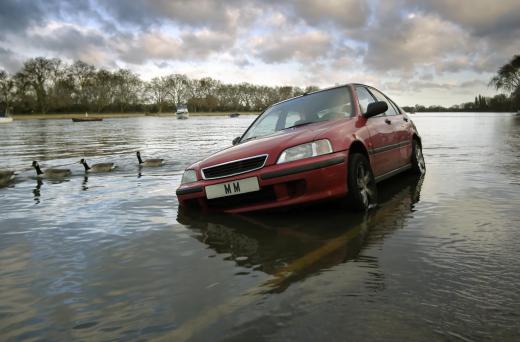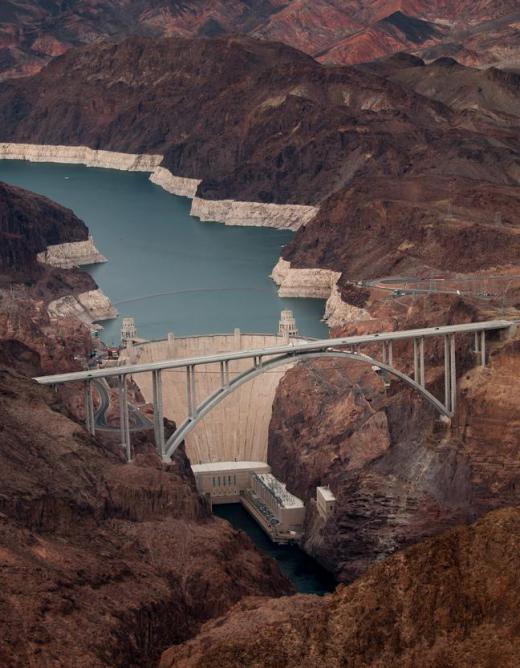What is a Flash Flood?
 Malcolm Tatum
Malcolm Tatum
Flash floods are incidences of rapid flooding in which low-lying areas are completely submerged. In many instances, one occurs as the result of some type of natural phenomena like heavy rains, hurricanes, or some type of tropical storm. A flash flood may also occur due to the collapse of a natural or man-made dam, however. There is usually very little advance warning that a given area will flood, making it somewhat difficult for people living in the affected area to determine whether or not to seek higher ground.
When this type of flood takes place due to natural phenomena, the process often begins with the ground becoming so saturated with rainfall that it is unable to absorb all the water that has fallen in a short period of time. Since water will run downhill, it will tend to collect in low-lying areas. If the rain or other weather condition does not abate, the water level will rise, eventually covering the area completely. Any homes or other structures in the area are flooded and likely to sustain damage.

When the flash flood is cause by the collapse of a natural or man-made dam, there may be no advance notice to warn people to leave the area. Because of its rapid discharge, the water has a tremendous ability to not only damage but to completely destroy anything in its path. Entire towns have been destroyed due to the collapse of a dam, leaving little behind but building foundations and the accumulated rubble from upstream sources.

A sudden flood that completely engulfs an area is sometimes referred to as a super soaker flash flood. This type of flooding activity is likely to completely cover entire structures; depending on the water current, the water in the flooded area may be relatively calm and begin to subside after the rain stops. If there is a strong downstream current, however, the soaker flood may uproot trees as well as buildings, and move them miles away from their original location.

In order to minimize the loss of life that can come with a flash flood, many communities have implemented some type of early warning system. In the event that there is a strong suspicion that heavy rain will cause low lying areas to flood, people may be urged to leave the area until it is determined that it will not be subject to flooding. Warning systems to alert people that a dam has collapsed are also common to many municipalities. It is not unusual for escape routes to be pre-planned, allowing people to know which roads to take and which direction to travel in order to get out of the way of the impending flood in the most efficient manner.
AS FEATURED ON:
AS FEATURED ON:

















Discussion Comments
@seag47 – Consider yourself lucky. My poor sister lives in the lowest spot in her county, and her house always gets water in it during flash floods.
It's very unfortunate that flash floods often occur with other extremely dangerous weather, like tornadoes. I live in tornado alley, which also seems to be flash flood alley at times.
My storm cellar is at the end of my driveway, so it's very hard to run out during a flash flood to take cover during a tornado warning. So, if a flash flood warning gets issued, I go ahead and run to the cellar, just in case a tornado warning will follow.
I live on a hill, so the flash flood guidance offered on television by meteorologists during storms has never really applied to me. All the rain does is saturate my yard with puddles and flow down the road to a lower spot.
I live on a road with a couple of low spots surrounded by ponds and streams, so my parents taught me some rules involving flash flood safety. Their number one rule was never to go into the water after the rain had stopped.
It was very tempting, because I could hear the rush of what sounded like a waterfall, and I loved playing in water. They told me that just a few inches of water on the road could wash me into the current of the stream, though. The stream water was angry, and the thought of being trapped there was scary enough to make me stay out of it.
When I got old enough to drive, they also told me never to drive through the water on the road during a flash flood. It takes surprisingly little water to wash a car off the road, and since you really can't tell how deep it is until you drive through it, it is best to avoid it.
Wow, I can't imagine how terrifying it would be to hear flash flood information about a dam breaking near your home! I wonder if it would even be possible for people to drive fast enough to escape the water.
I suppose it would depend both on how close you lived to the dam and how many other people were on the roads trying to escape. I would hope that in that situation, everyone would speed and no one would cause a traffic jam by driving slowly.
What are some flash flood safety tips? I am going on a weeklong mountain biking trip in the desert this summer, and I have been told that flash floods are a common occurrence during summer monsoons. What should I know about flash floods before I take my trip? How do I take care of myself in case I am caught in a flash flood? Any advice from desert outdoors people would be great.
@Georgesplane- I was vacationing on the big island a few years ago and I saw a flash flood video on the news that was amazing. An entire hillside was flooded out where no stream, river, or water source had ever been. The weather during the video was sunny too. The news said that the water was just the result of a heavy downpour much higher up the mountain.
The flood looked like an avalanche of water. There were rocks, trees, clumps of turf and other debris just flowing down the hill in a rushing torrent of water for at least five minutes of home video. After watching that video, I understand why so many Hawaiian homes are built on stilts.
I used to live in Hawaii, and flash floods are a common occurrence in many places. There was a gulch and a stream behind my house that had a great waterfall and swimming pool. It was a steep hike to get down in to the gulch, and could take minutes to get back up.
During heavy tropical rains, the gulch would flood unpredictably. The waterline was about ten feet above the normal water level in the ravine, showing just how dangerous these floods could be.
I have never been caught in the bottom during heavy rains, but I have hiked almost to the bottom only to find that the water level in the stream was about five feet higher than normal. The eeriest thing is that the flash flood can be a result of adverse weather elsewhere. The times I went down to find high water levels were on sunny days near my house but rainy days at the streams source. It is best to heed flash flood warnings because they can be deceptive.
Post your comments